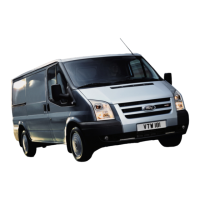Dimensions - not to exceed for Chassis Cab body Length
Long Wheel-
base 3954
Medium Wheel-
base 3504
Short Wheel-
base 3137
Wheelbase
Maximum allowable by territorial legislationMaximum recommended rear
overhang (requires self supporting
body or continuous sub frame).
A
252320731706Front outside of body to rear axle
- Single Cab
B
17091259-Front outside of body to rear axle
Double Cab
210021002100Maximum external body width
short mirror arms
C
230023002300Maximum external body width long
mirror arms
Maximum allowable by territorial legislation (We recom-
mend up to 2,4m over top of frame).
Maximum recommended external
body height (1) Rear Wheel Drive
(RWD) and Front Wheel Drive
(FWD)
D
25 minimumE
30 minimumF
Ensure local lighting legislation is maintainedG
Under run bar and towing couple legislation must be maintainedH
1.14.2 Recommended Nominal
Body Lengths for Chassis Cab
models
The following is the recommend method for
selecting best fit body lengths to suit the Chassis
Cab range, dependant on the load biases of the
conversion
Body lengths shown in the following charts are
given for guidance only, based on a minimum
specification chassis including driver, spare wheel
and full fuel. In the case of Uniformly Distributed
Load (UDL) figures the combined body and
payload Center of Gravity (CofG) is positioned
midway along the internal length of the body.
Body lengths are given as Nominal or Maximum.
Under most conditions the nominal body length
is recommended, maximum body length should
only be used when a nominal length body cannot
accommodate a specific load length requirement.
CAUTION: When considering
maximum length bodies, payload
latitude and flexibility will be reduced
as the available rear axle capacity
is used to the full. Non Uniformly
Distributed Load (UDL) loads that
are rearwards biased, should not be
used with maximum length bodies.
In order to achieve the largest load latitude
nominal (rearward biased) body lengths are the
primary recommendation. However recognizing
each body and its associated payload will have
an infinite number of CofG positions, in addition
to the large number of chassis specifications, it
is recommended that the chassis kerb weight
and plated weights are determined before a
weight distribution calculation is performed.
Chassis specification is assumed minimum with
base engine and drivetrain, any additional
equipment or alternative drivetrain's may reduce
the body length. It is recommended that physical
Chassis kerb weights are established to calculate
weight distribution when ever a body length
greater than nominal is considered.
Bodywork longer than the nominal dimension
may require a rear overhang extension with the
repositioning of the rear light bar and extension
electrical supply circuits. Body floor height may
require an increase in height to accommodate
angle of vision requirements for rear light and
license plate.
430 derivatives are fitted with a rear under-run
bar, modification of the rear overhang may
invalidate approvals, consult your local National
Sales Representative before considering
modification.
FordTransit 2006.5 (April 2006–)
Date of Publication: 12/2006
1 General Information
36

